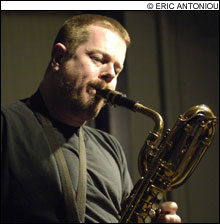 I know of no single, clear definition of “free bop,” but I think I know it when I hear it, and I’d say no one does it better than the Vandermark 5. When this band out of Chicago play Ken Vandermark’s pieces or his arrangements of jazz classics, it means bop phrasing, lots of walking-four swing rhythms, tight ensemble arrangements, tunes with or without chord changes, and the freedom to adhere to them or not, to step outside changes and time signatures, but always to return.
I know of no single, clear definition of “free bop,” but I think I know it when I hear it, and I’d say no one does it better than the Vandermark 5. When this band out of Chicago play Ken Vandermark’s pieces or his arrangements of jazz classics, it means bop phrasing, lots of walking-four swing rhythms, tight ensemble arrangements, tunes with or without chord changes, and the freedom to adhere to them or not, to step outside changes and time signatures, but always to return.
February 1 at the Artists-at-Large Gallery in Hyde Park, the Vandermark 5 played to a room of the faithful, 50 or 60 people in a church basement, some standing against a wall. Vandermark — a Massachusetts native but a long-time member of the Chicago scene — has worked hard building an audience, crossing over to rock clubs, releasing slews of albums on his own imprints and small labels like Atavistic and Delmark. At Artists-at-Large, the first set featured older pieces, mostly from the recent double CD The Color of Memory (Atavistic), rearranged since the arrival of the band’s new cellist, Fred Lonberg-Holm, last summer (replacing trombonist Jeb Bishop). The second was mostly new material.
You could hear why Vandermark has made inroads with indie-rock audiences — he contains all the hallmarks of free jazz in succinct song-like forms while remaining gratifyingly unruly. Solos are long but never too long, and songs might run 10 minutes but never 20. The Artists-at-Large opener, “Vehicle,” began in free–tempo, Vandermark on baritone and Dave Rempis on tenor alternating roles in a slow call-and-response. Then it came together for a brief unison secondary theme, then a repeat of the first theme before driving into a third, a kind of minor march over a hard, straight-ahead walking bass, then into a jaunty boppish tune on top of a driving rhythm-section vamp. The theme kept morphing, and so did the backing rhythms, before breaking for solos. And that’s another Vandermark signifier — an endless supply of strong, riffy tunes.
The playing was spectacular all night. Rempis — on tenor and alto — has a fluid bebop style, unwinding pearly strings of eighth notes, and he likes to play changes, always setting up clear anticipation and resolution in the arcs of his solos before going off the page with controlled squawks and squeals and other “outside” excursions. Vandermark, who played clarinet, bass clarinet, and, mostly, baritone sax, leaned more toward riffing, gestural solos, building on rhythmic patterns, breaking them apart, with a tendency to smear his sound with slurs and honks. His lower register on the big horn shook the small room. At times, Vandermark and Kessler went head to head, playing roiling counterlines while the rhythm section steamed away — the freest sections of this bop.
But it was the arrangements themselves that made things work — drummer Tim Daisy’s shifting colors and rhythmic cues, the alternation of bowing and kora-like pizzicato from both Lonberg-Holm and bassist Kent Kessler. From time to time, the ensemble would come together for quiet, encouraging unisons behind the soloists. When Vandermark’s pieces end, it’s usually with a tight, forte unison hard stop: BANG!